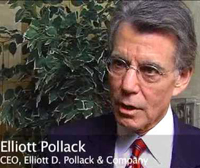The Monday Morning Quarterback: A quick analysis of important economic data released over the last week
It was a busy week for economic data. Probably the most noteworthy was the data on employment. Total nonfarm payroll employment in the U.S. rose by 114,000 in September. This was modestly above expectations and continued the string of positive, but mediocre results that has defined 2012. The 114,000 growth in jobs compares to the monthly average of 146,000 for the first nine months of 2012 and the 153,000 that was the monthly average job growth in 2011. While the number of unemployed declined, it was largely due to people (discouraged workers) dropping out of the labor force. The labor force participation rate peaked at over 67% in 2000. It has now declined to 63.5%, a level not seen since 1982. Thus, it is really no big surprise that the unemployment rate declined 7.8% after remaining in a narrow band (8.1% – 8.3%) over the first eight months of the year. In addition, initial claims for unemployment insurance were 367,000. This is the same range as the last several weeks.
Economic activity in the manufacturing sector expanded in September following three consecutive months of slight contraction. The index, issued by the Institute for Supply Management, was 51.5%. Any reading of above 50% indicates expansion. The overall economy grew for the 40th consecutive month. The non-manufacturing index grew for the 33rd consecutive month. New orders for manufactured durable goods were down in August following three months of increases.
Institute for Supply Management, was 51.5%. Any reading of above 50% indicates expansion. The overall economy grew for the 40th consecutive month. The non-manufacturing index grew for the 33rd consecutive month. New orders for manufactured durable goods were down in August following three months of increases.
U.S. consumer credit increased greater than expectations. On a seasonally adjusted basis, credit grew at an 8% annual rate. In August, both revolving (+5.9% SAAR in August) and non-revolving (+9.0% SAAR in August) were up. This is troublesome in some ways. Previously in this recovery, the increases in credit were in non-revolving borrowing for items like cars and light trucks. In August, revolving credit was up as well. Up until recently, consumers had been paying down their credit in an attempt to get their financial house in order. Unfortunately, much of the decline in consumer’s debt burden ratio (payments to income) has declined due to lower interest rates. Those lower rates could prove to be transitory. Whether this increase in revolving credit is transitory or not remains to be seen. As for non-revolving credit, auto and light truck sales now stand 16.5% above year earlier levels.
As for Greater Phoenix, single-family home prices rose slightly between July and August 2012 but, continue to show a very significant recovery over the past year. Median prices were up 33.7% over that past year. Most of the increases were in distressed properties. For example, sales prices of trustee sales to third parties were up 31.2%. HUD sales prices were up 37.7%. REO sales prices were up 39.3% and bank owned sales prices were up 59.5%. The sale on homes in Greater Phoenix seems to be ending. As the supply of distressed homes diminished relative to demand, prices increase. On the other hand, sales prices of normal resales were up only 6.9% and new home prices were up 6.8%.over the past year. As the number of distressed properties continues to decline, both non-distressed and new home prices will increase more rapidly.










